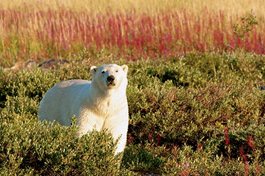
The small subarctic Canadian town of Churchill, Manitoba, located on the western shores of Hudson Bay is home to fewer than 900 inhabitants. That is, if you don’t include the polar bears. Include them, and the population of Churchill more than doubles. The 900-1000 polar bears that inhabit the Western shores of Hudson Bay have given Churchill - the only town in the world to boast a “polar bear jail” - its moniker of “The Polar Bear Capital of the World.”
Churchill’s “Ice Bear” residents constitute just one of the 19 polar bear populations in the world, tracked by international environmental observers, and of these, Churchill’s are by far the most accessible. Unlike their more southern brethren the brown and black bears, polar bears do not hibernate in the winter, but rather spend the winter hunting for their primary source of nourishment: arctic seals on the vast expanses of ice. When the Hudson Bay’s ice melts, summer provides a unique and spellbinding opportunity to observe the bears meandering along the shores amongst purple wildflowers, and keeping cool by swimming in the open waters.
The polar bear-
Ursus maritimus - is the world’s largest land carnivore, weighing in at 1,320 lbs. and standing approximately 10 feet. Despite their immense size, polar bears are surprisingly agile and fast, particularly in the water where their long necks and narrow skulls help propel them through the water, and their-partially webbed paws enable adults to swim up to 100 miles at an impressive speed of six miles per hour. Polar bears sit at the top of the arctic food chain, subsisting on the fat of the seals and leaving the remains for other species to feed upon. Though they live on land, a thick 4-inch layer of blubber under their oily fur coat enables polar bears to remain buoyant in the water and tolerate the icy wind and sub-zero temperatures on land during the long winter. In the frigid waters they hunt their quarry using their highly-developed sense of smell to detect seals up to three feet below the ice. Summer, by contrast, is a time of laziness, as the bears wait for the ice to form once again. During these relatively warm summer months, it’s truly spectacular to view the snow white Polar Bears contrasted by a landscape of green grasses, evergreen taiga, wildflowers, and blue waters.
Churchill offers an excellent opportunity to observe female polar bears nurturing their cubs along the rocky shoreline, or as they teach the cubs to swim in the summers open waters. A female polar bear gives birth on average to five times during her lifespan with a litter of only 1-2 cubs. This makes polar bears one of the least fecund mammals. Polar bear cubs gestate eight months and are born in mid-winter, hairless and the approximate size of rats. To survive the icy cold and wind, cubs must be protected, fed, and nurtured by their mother in a warren of dens built into the ice and snow until they reach 20-30 lbs. and can emerge small and vulnerable. Cubs remain with their mothers for an additional two years until they can subsist on their own, having grown strong enough to hunt for their own food and large and powerful enough to withstand the cold currents that present an ever present threat of drowning.
With no predator of their own in the animal kingdom, polar bears are known as “the Lords of the Arctic.” In the last century, however, climate change, pollution, and arctic oil exploration and extraction by humans have placed the polar bears’ - and thereby the entire Arctic’s - ecosystem under threat of extinction. The authoritative World Wildlife Fund has designated the species as “vulnerable,” watching with alarm as the polar bear population declines steadily.
In late 2017, disturbing video and photos, from conservation group “Sea Legacy,” of a starving and emaciated polar bear searching in vain for seals among melted ice blocks brought this issue into mainstream news and consciousness; it is to be hoped that these will continue heighten awareness of the desperate need to address the issue of climate change.
In Churchill, where the economy depends on its visitors, every care is taken to preserve and protect the fragile ecosystem that keeps the polar bears returning each season.
Join Alexander + Roberts on an unforgettable journey to “The Polar Bear Capital of the World,” on our special itinerary to meet
The Polar Bears of Churchill. Guided by knowledgeable and experience experts, you’ll have the opportunity to observe the Lords of the Arctic in their natural summer habitat. Furthermore, summer in Churchill experiences a mass migration of 160,000 beluga whales, which Alexander + Roberts guests will meet quite literally face to face! Always capped at 16 guests for an intimate and unforgettable experience.